- Naked necked chicken in music video shock.
- Piment d’Espalette. Jeremy asks “What’s the big deal, really?”
- The ITPGRFA on CNN.
- Fiji to set up breadfruit genebank.
- Lacto-fermenting your eggplant and chrysanthemum petals.
- More on FAO’s Indigenous Peoples’ Food Systems book.
- “Where farming communities have been able to maintain their traditional varieties, they are already using them to cope with the impacts of climate change.”
- Yam Minisett Technology pushed.
Marina of the Zabballeen does the rounds
We’ve blogged a few times about the plight of the Zabballeen — Cairo’s Coptic garbage collectors and pig-keepers — in the wake of the pig cull which was the Egyptian governments main response to swine flu. Now, via Treehugger, comes news of a movie about this embattled community: Marina of the Zabballeen. It seems to have done quite well on the festival circuit. If you caught it, let us know.
Reporting threats to agrobiodiversity: A modest proposal
Yesterday Hannes, à propos of something else, reminded me of a post I did a few months back about ProMED which asked the question “Why do we still not have an early warning system for genetic erosion?” Today I read about pestMapper — “[an] internet-based software tool for reporting and mapping biological invasions and other geographical and temporal events.” Whose objectives is basically to make a more participatory, Web 2.0-like ProMED. Coincidence? Maybe. Anyway, this is exactly the kind of thing we’ve been thinking here a “global genetic erosion threat reporting and monitoring portal” might look like. Any thoughts? An idea worth pursuing?

Nibbles: Chicory symbolism, Watermelon disease, Olive documentation, Camassia quamash, Pig maps
- Chicory averts evil. Gotta get me some.
- Genebank watermelon material reveals sources of resistance to WVD caused by SqVYV. What?
- Israelis, Palestinians and Germans collaborate on DNA fingerprinting and quality evaluation of olive trees. Wait, what? Scroll down.
- Genetic structure of Native American food plant not really affected by Native Americans. This is the bulb that kept Lewis & Clark alive, apparently.
- Tracing Paper compares hog distribution in 1922 and now, finds little difference.
Nibbles: Svalbard, Consumers, Seed law, Fragrant rice, Five Farms on radio, Invasive plant used, Genetic diversity and latitude, Coffee and tea in history, Coconut disease
- “Sustainable food production may not begin in this cold Arctic environment, but it does begin by conserving crop diversity.” Words of wisdom from the frozen lips of Ban Ki Moon.
- Organic vs local. A survey.
- Civil Society opposes seed laws in Chile.
- Jeremy gets stuck into a bowl of basmati and Five Farms.
- “Pest to pesto.”
- Tropical fruit flies have less genetic diversity than temperate fruit flies, may have trouble adapting to climate change.
- “It is difficult to imagine what the first taste of sugar or coffee must have been like to those accustomed to weak beer and bread.”
- Lethal yellowing spreads in Ghana?